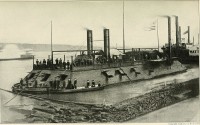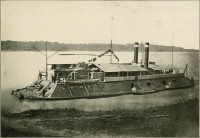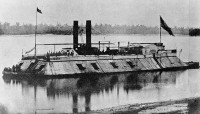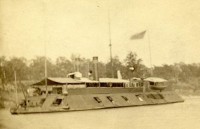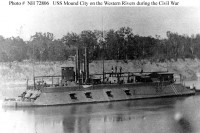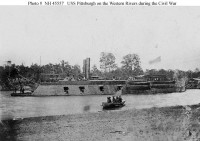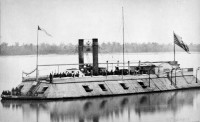City-class ironclad
Basic information
Ship measurements
Machine
- 2 * non-condensing reciprocating steam engines
- 22 ft (6.7 m) diameter paddle wheel
Personnel
Combat assets
- 2.5 in (64 mm) on casemate
- 1.5 in (38 mm) on pilot house
- hull, deck, and stern unprotected
- 3 * 8-in (203 mm)
- 4 * 43-pounder (19 kg)
- 6 * 32-pounder (14.5 kg)
The Pook Turtles, or City-class gunboats to use their semi-official name, were war vessels intended for service on the Mississippi River during the American Civil War. They were also sometimes referred to as «Eads gunboats.» The labels are applied to seven vessels of uniform design built from the keel up in Carondelet, Missouri shipyards owned by James Buchanan Eads. Eads was a wealthy St. Louis industrialist who risked his fortune in support of the Union.
The City-class gunboats were the United States' first ironclad warships.
The gunboats produced by Eads formed the core of the US Army's Western Gunboat Flotilla, which later was transferred to the US Navy and became the Mississippi River Squadron. Eads gunboats took part in almost every significant action on the upper Mississippi and its tributaries from their first offensive use at the Battle of Fort Henry until the end of the war.
Armament
Positions were provided for 13 guns. Three gunports faced forward, four were on each side, and two aft. When they were first commissioned, the armament of most vessels of the class consisted of six 32-pounder and three 8-inch Dahlgren smooth bore guns and four 42-pounder army rifles. The exception was St. Louis (later Baron De Kalb), which had seven 32-pounders and two 8-inch Dahlgrens. In addition, some carried a single 12-pounder boat howitzer that is not counted as part of the armament. The mix of guns was changed later in the war.
Armor
The casemate armor was 2.5 inches (64 mm) thick, rolled in plates 13 inches (33 cm) wide and 8 to 13 feet (2.44 to 3.96 m) long. Total weight of the armor was 75 tons (68 tonnes). Pook's initial design called for armor only on the sides abreast the engines; Commander Rodgers, however, extended the plating to cover the forward casemate. The after casemate, hull, and deck not covered by the casemate were left unprotected. An additional 47 tons (43 tonnes) of armor was put on following the battle of Fort Pillow. At the same time, protection against ramming was given to the hulls by railroad iron at the stems and sterns.
Engines
The engines were designed by engineer Thomas Merritt. The 22-foot (6.7 m) paddlewheel was driven by two steam engines, mounted at opposite ends of the axle, 90 degrees apart. Five boilers, 36 inches (0.91 m) in diameter and 24 feet (7.3 m) long, gave steam to a cylinder 22 inches (0.56 m) in diameter with a six-foot (1.8 m) stroke.
The initial placement of the engines proved to be unsatisfactory. In order to protect them from enemy shot, they had been crowded into shallow holds, causing the engines to work both water and steam. To remedy the problem, the steam drums had to be moved to the top of the boilers. This meant that they were no longer fully protected.
Evaluation of the gunboats
The only meaningful evaluation of a warship is by comparison with its contemporaries in function. By this scale, the City-class gunboats must be given very good grades, as they combined firepower, protection, and mobility in a manner achieved by few of their contemporaries. Nevertheless, they had certain design flaws that would have had to be corrected in later ships of their general type.
Their weakest point was the hull. Not only was the hull easily penetrated, but once breached, there was no way to isolate the damage, such as by watertight compartments. This made them vulnerable to mines (Cairo and Baron De Kalb) and to ramming (Cincinnati and Mound City).
Their armor was inadequate in two respects: both the deck and the stern were uncovered. The lack of deck armor made them vulnerable to plunging fire, which they encountered most famously at the Battle of Fort Donelson. The gaps in the armor left the steering cables uncovered, so at Fort Donelson and other encounters, their steering was knocked out rather easily.
In common with all other ships of their era, no provision was made for confining escaping steam if the boilers were to suffer battle damage. The most prominent example of the evil consequences of this lack of foresight was the Mound City disaster of 17 June 1862, but other ships suffered similarly, if not to the same degree.
The peculiar three-keel construction and confined paddlewheel created steering problems that are often overlooked. The gunboats could not be backed against the current. These handling characteristics affected their use at the Battles of Island Number Ten and Memphis.
Today
The wreck of USS Cairo was located in 1956 and has been recovered. The gunboat and associated artifacts are now displayed in a museum in Vicksburg National Military Park, maintained by the National Park Service.
Ships7
- Comments
 en
en ru
ru uk
uk
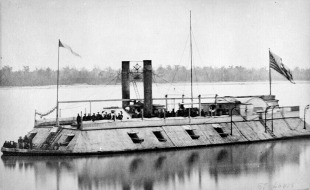
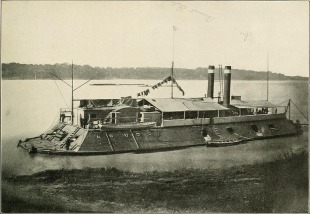
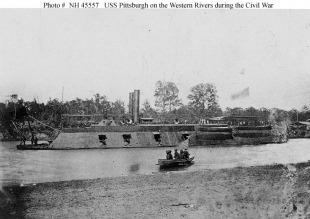
 Union Navy
Union Navy United States Army
United States Army United States Navy
United States Navy